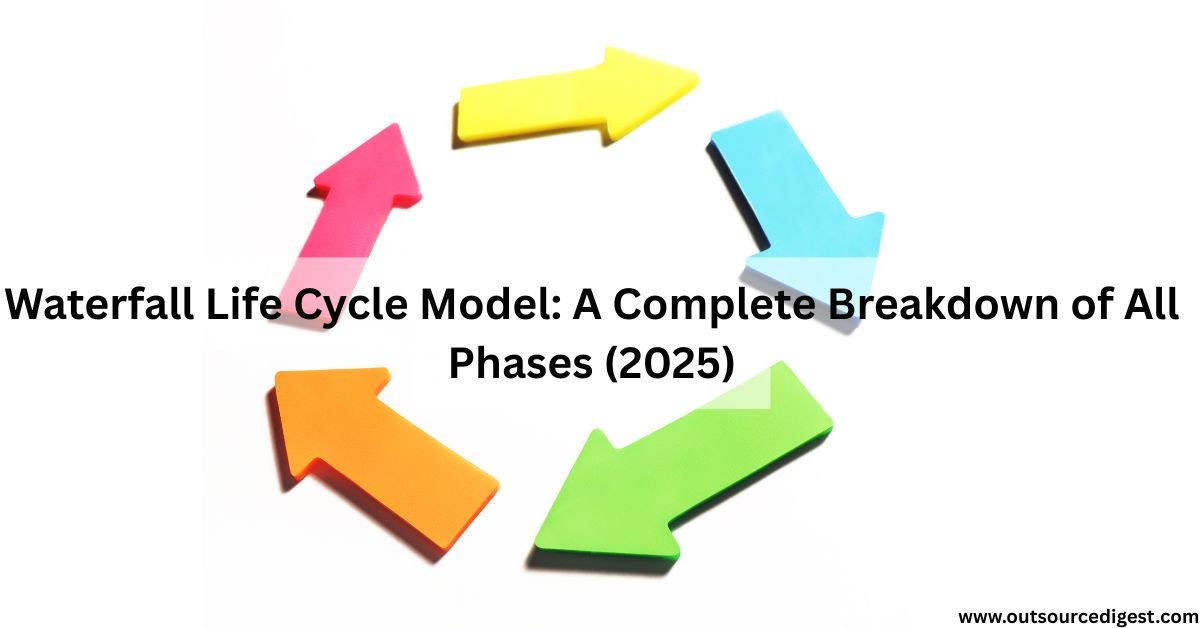In this article, you will learn everything about the waterfall life cycle model, including all six structured phases, their inputs, outputs, and how they work together in software project planning and execution.
The waterfall life cycle model is a structured, sequential approach to project execution. Each phase must be completed in full before the next one begins, and no phase overlaps. This model is best suited for projects where requirements are clearly defined and changes are unlikely during development.
Now, we’ll walk through each of the six main phases of the waterfall model life cycle, breaking down the purpose, structure, inputs, and outputs of each phase, without diving into examples, pros, or cons.
Overview of the Waterfall Life Cycle Model
The waterfall model follows a strict top-down flow. Once a phase is completed, the project progresses forward without revisiting earlier stages. The typical life cycle includes the following six phases:
- Requirements Gathering and Analysis
- System Design
- Implementation
- Testing
- Deployment
- Maintenance
Each of these stages produces specific deliverables that feed directly into the next phase. The waterfall life cycle model emphasizes documentation and approval before moving forward.
Waterfall Model Life Cycle Phases
1. Requirements Gathering and Analysis
All functional and non-functional requirements are collected at this stage. Stakeholder input is formalized into detailed documentation that guides the entire project.
Goal:
- Define all functional and non-functional requirements before development starts.
Key Activities:
- Meet with stakeholders to collect needs
- Document system behavior and constraints
- Establish performance, security, and usability goals
Inputs:
- Business needs
- Stakeholder interviews
- Regulatory standards (if applicable)
Outputs:
- Requirements Specification Document (RSD)
- High-level use case descriptions
- Approval sign-off from all stakeholders
This phase forms the foundation of the entire waterfall life cycle model. Without clarity here, all downstream phases risk failure.
2. System Design
The design team creates both high-level and detailed system architecture. Diagrams, UI mockups, and technical specifications are finalized here.
Goal:
- Translate requirements into a structured plan for how the system will work.
Key Activities:
- Design the overall system architecture
- Create database schemas and data models
- Define interface layouts and workflows
- Select development tools and technologies
Inputs:
- Approved requirements documentation
Outputs:
- System Design Document (SDD)
- Architecture diagrams (e.g., ERD, UML)
- UI/UX wireframes
- Technical stack definition
This is the blueprint of the system. The waterfall life cycle model requires complete design documentation before coding begins.
3. Implementation
Developers begin coding based on the previously approved design. The output is a working version of the product with all required features.
Goal:
- Convert the approved design into actual working software.
Key Activities:
- Code all system modules
- Integrate internal and third-party components
- Follow defined coding standards
- Maintain version control
Inputs:
- Design documents
- Coding guidelines
- Project timeline
Outputs:
- Fully functional source code
- Internal module tests
- Integration-ready software
The implementation phase in the waterfall life cycle model does not allow major design changes—it strictly follows the plan laid out in the previous phase.
4. Testing
Quality assurance teams test the product against the documented requirements. Functional testing, integration testing, and system testing occur in this phase.
Goal:
- Validate that the software meets all requirements and works as expected.
Key Activities:
- Develop test cases and scripts
- Conduct unit, integration, and system testing
- Log defects and verify fixes
Inputs:
- Completed software modules
- Requirements documentation
- Test plans
Outputs:
- Test summary reports
- Defect tracking logs
- Verified test cases (pass/fail results)
Testing is critical in the waterfall life cycle model, and it is performed after the full system is built, not in parallel.
5. Deployment
Once the system passes QA, it’s released to the production environment. In traditional waterfall, this happens all at once rather than incrementally.
Goal:
- Release the final, tested product to the production environment.
Key Activities:
- Prepare production servers or environments
- Finalize user manuals and documentation
- Conduct a go-live checklist
Inputs:
- Tested and approved system
- Deployment plan
Outputs:
- Live software running in production
- Installation logs
- Release documentation
In the waterfall life cycle model, deployment is usually done in a single release, not in iterations or stages.
6. Maintenance
Bug fixes, updates, and user support are handled in this final phase. While the core project is complete, ongoing technical support continues.
Goal:
- Ensure the software remains functional and up to date after release.
Key Activities:
- Monitor performance and bugs
- Apply updates and security patches
- Respond to user feedback
- Prepare for future enhancements
Inputs:
- User reports
- Performance metrics
- Change requests
Outputs:
- Maintenance logs
- Patch releases
- Updated documentation
Even though the waterfall life cycle model ends formally after deployment, the maintenance phase ensures long-term system stability.
Conclusion
The waterfall life cycle model provides a highly disciplined and linear path from requirements to release. Each phase builds on the deliverables of the previous one, requiring full completion and approval before moving forward.
By understanding every stage in detail—including its activities, inputs, and outputs—you can better manage structured projects that demand consistency, documentation, and accountability.
Looking for a broader overview of how Waterfall compares to other models?
Check out our full guide on the Waterfall Model in Software Development







